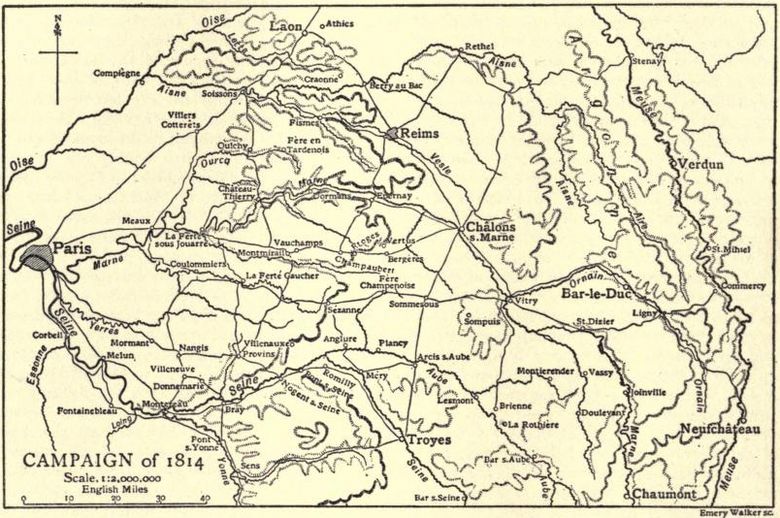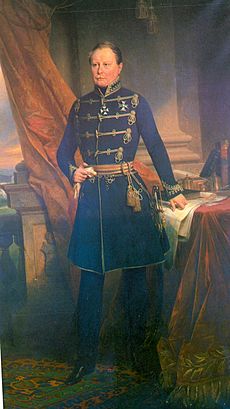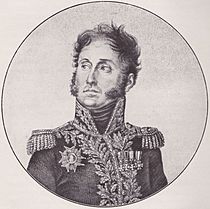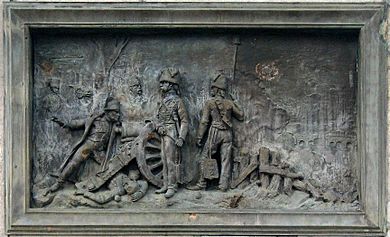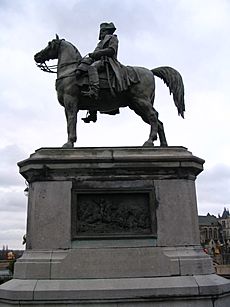Battle of Montereau facts for kids
Quick facts for kids Battle of Montereau |
|||||||
|---|---|---|---|---|---|---|---|
| Part of the Campaign of France of the Sixth Coalition | |||||||
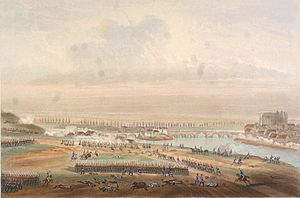 Battle of Montereau by Adolphe Rouargue |
|||||||
|
|||||||
| Belligerents | |||||||
| Commanders and leaders | |||||||
| Strength | |||||||
| 30,000 70–80 guns |
15,000–18,000 40 guns |
||||||
| Casualties and losses | |||||||
| 2,000–3,000 killed, wounded, or captured | 5,000–6,000 killed, wounded, or captured 2–15 guns lost |
||||||
The Battle of Montereau happened on February 18, 1814. It was part of the War of the Sixth Coalition, a big conflict where several European countries fought against Napoleon's France. In this battle, Napoleon led his French army against soldiers from Austria and Württemberg. These enemy forces were led by Crown Prince Frederick William of Württemberg.
Earlier, Napoleon had won some battles against another Allied army. But the main Allied army, led by Karl Philipp, Prince of Schwarzenberg, was getting very close to Paris. Napoleon quickly moved his smaller army south to stop Schwarzenberg. When the Allied commander heard Napoleon was coming, he ordered his troops to retreat.
However, on February 17, Napoleon's forces caught up with the Allied rear guards. The next day, the Crown Prince of Württemberg was told to hold the town of Montereau-Fault-Yonne until nightfall. He placed many soldiers on the north side of the Seine River. For most of the day, the Allies bravely fought off French attacks.
But as the French pushed harder in the afternoon, the Allied lines broke. Their soldiers rushed towards the only bridge behind them. French cavalry, led by Pierre Claude Pajol, charged into the fleeing enemy. They captured the bridges over both the Seine and Yonne Rivers, taking control of Montereau. The Allies lost many soldiers. This defeat made Schwarzenberg continue his retreat towards Troyes.
Contents
Why the Battle Happened
Allied Armies Move Forward
In February 1814, the Allied armies were moving deeper into France. One main army, led by Prince Schwarzenberg, advanced from Troyes. Their goal was to reach Paris.
They captured several towns along the Seine River, like Nogent and Bray. French forces, including the National Guards, tried to defend these areas but were often too weak. By February 15, the French were retreating very close to Paris. People in Paris started to panic, hearing that a huge enemy army was approaching.
Napoleon's Counterattack
After winning some battles in the "Six Days' Campaign," Emperor Napoleon quickly turned his attention south. He wanted to stop Schwarzenberg's army from reaching Paris. Napoleon left his other generals to watch the enemy and rushed his best troops, the Imperial Guard, south.
His soldiers marched incredibly fast, covering long distances in a short time. When Prince Schwarzenberg heard about Napoleon's quick approach and his recent victories, he became cautious. He ordered his army to retreat and put the Seine River between them and Napoleon.
On February 17, Napoleon's leading troops attacked a Russian force at the Battle of Mormant. The Russians suffered heavy losses. The French then pushed back other Allied forces. Napoleon divided his army into three groups to chase the retreating Allies. He was very determined to catch them.
The Battle of Montereau
Who Fought There
The Allied forces at Montereau were led by Crown Prince Frederick William of Württemberg. He had about 11,000 soldiers from Württemberg and 4,000 from Austria, totaling around 15,000 troops. They also had about 40 cannons.
The French army was led by Emperor Napoleon himself. His forces included several army corps and the famous Imperial Guard. They had about 30,000 soldiers and 70 to 80 cannons.
The Fight Begins
Napoleon wanted his troops to reach Montereau early on February 18. However, the first French soldiers, mostly cavalry and National Guards, arrived around 8:00 AM. They were not strong enough to break through the Allied defenses.
The town of Montereau is on the south bank of the Seine River. But the north bank has a tall hill with a steep slope, perfect for defense. The Allies had placed their cannons and soldiers on this hill, overlooking the bridges and the town.
The French launched several attacks, but the Allies fought bravely and held their ground. One French general, Chateau, was badly wounded during these early attacks. Napoleon was very unhappy with the slow progress. He even replaced one of his generals, Marshal Victor, because he wasn't moving fast enough.
French Victory
In the afternoon, more French troops arrived, including the powerful Imperial Guard artillery. With 40 more cannons, the French now had a huge advantage in firepower. Around 3:00 PM, Napoleon ordered a massive attack. The French artillery fired heavily at the Allied positions.
The French infantry finally broke through the Allied lines. As the Allied soldiers began to retreat, French cavalry, led by General Pierre Claude Pajol, charged forward. The Allied retreat quickly turned into a confused rush towards the bridges.
The Crown Prince of Württemberg tried to rally his men but almost got captured. Napoleon ordered 60 cannons to fire at the fleeing enemy crowding the bridges. When his guards worried about his safety, Napoleon famously said, "Courage my friends, the bullet which is to kill me is not yet cast."
Pajol's cavalry charged into the chaos and managed to capture both the Seine and Yonne bridges before the Allies could destroy them. French infantry quickly followed, securing Montereau. The defeated Allied forces retreated in disorder.
What Happened After
The Battle of Montereau was a clear French victory. The Allies lost about 5,000 to 6,000 soldiers, either killed, wounded, or captured. They also lost around 15 cannons. The French had fewer losses, about 2,000 to 3,000 soldiers.
Even though it was a victory, Napoleon was still frustrated. He felt the enemy had been lucky and that he should have captured more of their cannons and supplies. He was also angry with some of his generals for not being fast enough.
Before the battle ended, Prince Schwarzenberg had already ordered his entire army to retreat further back to Troyes. The French pursuit was slowed down because many bridges had been destroyed. This gave the Allies a head start in their retreat. The war continued with more battles in the following days.
Battlefield Today
Today, part of the historic battle site near the town of Montereau-Fault-Yonne might become a theme park. This park, called Napoleonland, would celebrate the life of French Emperor Napoleon Bonaparte. It was originally planned to open in 2017.


